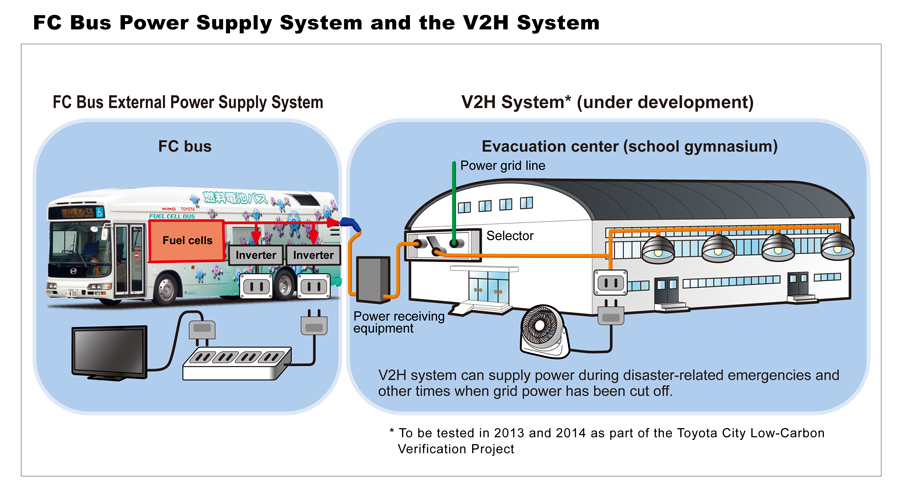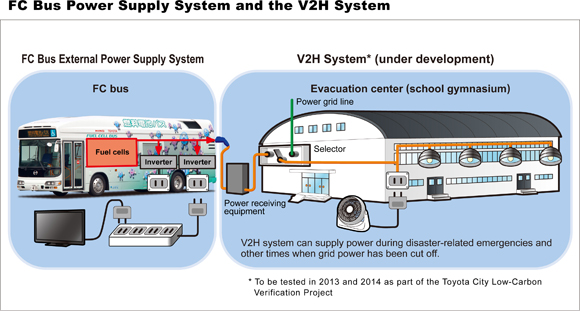Aug. 31, 2012
TMC Develops Fuel-cell-bus Power Supply System
Toyota City, Japan, August 31, 2012―Toyota Motor Corporation (TMC) has developed a power supply system that uses electricity generated within a fuel cell bus (FC bus) to supply electrical power to devices such as home electrical appliances.
An FC bus―based on the "FCHV-BUS"1―equipped with the new power supply system has two electrical outlets (AC 100 V, 1.5 kW) inside the cabin that can supply a maximum output of 3 kW and potentially power home appliances continuously for more than 100 hours.
As part of the emergency power-supply training section of the comprehensive disaster-control training to be conducted by Aichi Prefecture and Toyota City on September 2, the system2 is to power approximately 20 information display monitors inside a disaster control headquarters tent.
Fuel cell vehicles (FCVs), which generate electricity from hydrogen to power a drive motor, are considered to be a promising environment-friendly vehicle for the diversification of fuel sources and for the realization of zero emissions. Furthermore, FCVs can supply a much greater amount of electrical power than electric vehicles (EVs). Thus, FC buses, with their large amount of stored hydrogen, hold promise as potential mobile power-supply vehicles that can be used at such places as evacuation centers following disasters.
TMC is also developing a vehicle-to-home (V2H) system3 for supplying electricity from an FC bus to a building's existing electrical wiring with the goal of providing a maximum output of 9.8 kW for 50 hours. With a full tank of hydrogen, an FC bus with the V2H system could be used to power the lights inside an average school gymnasium (with a power consumption of approximately 100 kWh) for approximately five days4. TMC plans to test this V2H system for FC buses in 20135 and 2014 as part of the Toyota City Low-Carbon Verification Project, which has been adopted as one of the Next-Generation Energy and Social System Demonstration Projects being promoted by the Ministry of Economy, Trade and Industry.
An FC bus―based on the "FCHV-BUS"1―equipped with the new power supply system has two electrical outlets (AC 100 V, 1.5 kW) inside the cabin that can supply a maximum output of 3 kW and potentially power home appliances continuously for more than 100 hours.
As part of the emergency power-supply training section of the comprehensive disaster-control training to be conducted by Aichi Prefecture and Toyota City on September 2, the system2 is to power approximately 20 information display monitors inside a disaster control headquarters tent.
Fuel cell vehicles (FCVs), which generate electricity from hydrogen to power a drive motor, are considered to be a promising environment-friendly vehicle for the diversification of fuel sources and for the realization of zero emissions. Furthermore, FCVs can supply a much greater amount of electrical power than electric vehicles (EVs). Thus, FC buses, with their large amount of stored hydrogen, hold promise as potential mobile power-supply vehicles that can be used at such places as evacuation centers following disasters.
TMC is also developing a vehicle-to-home (V2H) system3 for supplying electricity from an FC bus to a building's existing electrical wiring with the goal of providing a maximum output of 9.8 kW for 50 hours. With a full tank of hydrogen, an FC bus with the V2H system could be used to power the lights inside an average school gymnasium (with a power consumption of approximately 100 kWh) for approximately five days4. TMC plans to test this V2H system for FC buses in 20135 and 2014 as part of the Toyota City Low-Carbon Verification Project, which has been adopted as one of the Next-Generation Energy and Social System Demonstration Projects being promoted by the Ministry of Economy, Trade and Industry.

1"Fuel cell hybrid vehicle-bus". Units of the FCHV-BUS are currently in use on various routes in Japan, such as within the environs of the Central Japan International Airport, between the Tokyo International Airport and the Tokyo metropolitan area, and within Toyota City.
2In both an FC bus and a gasoline-electric plug-in hybrid vehicle (PHV)
3V2H system for EVs and PHVs has already been developed (http://newsroom.toyota.co.jp/detail/153521)
4Calculated assuming the lights are kept on 12 hours a day
5Unless noted otherwise, years mentioned are from April 1 to March 31
2In both an FC bus and a gasoline-electric plug-in hybrid vehicle (PHV)
3V2H system for EVs and PHVs has already been developed (http://newsroom.toyota.co.jp/detail/153521)
4Calculated assuming the lights are kept on 12 hours a day
5Unless noted otherwise, years mentioned are from April 1 to March 31





